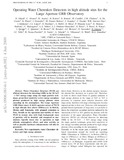Mostrar el registro sencillo del ítem
Operating water cherenkov detectors in high altitude sites for the large aperture GRB observatory
| dc.rights.license | http://creativecommons.org/licenses/by-nc-sa/3.0/ve/ | |
| dc.contributor.author | Allard, D. | |
| dc.contributor.author | Alvarez, C. | |
| dc.contributor.author | Asorey, H. | |
| dc.contributor.author | Barros, Humberto J. V. | |
| dc.contributor.author | Bertou, Xavier | |
| dc.contributor.author | Castillo, M. | |
| dc.contributor.author | Chirinos, J. M. | |
| dc.contributor.author | De Castro, A. | |
| dc.contributor.author | Flores, S. | |
| dc.contributor.author | González, J. | |
| dc.contributor.author | Gomez Berisso, M. | |
| dc.contributor.author | Grajales, J. | |
| dc.contributor.author | Guada B., Carlos E. | |
| dc.contributor.author | W.R. Guevara, Day | |
| dc.contributor.author | Ishitsuka, J. | |
| dc.contributor.author | López, J. A. | |
| dc.contributor.author | Martínez, O. | |
| dc.contributor.author | Melfo, A. | |
| dc.contributor.author | Mezal, E. | |
| dc.contributor.author | Miranda Loza, P. | |
| dc.contributor.author | Moreno Barbosa, E. | |
| dc.contributor.author | Murrugarra, C. | |
| dc.contributor.author | Núñez, Luis | |
| dc.contributor.author | Otiniano Ormachea, L. J. | |
| dc.contributor.author | Pérez, G. | |
| dc.contributor.author | Pérez, Y. | |
| dc.contributor.author | Ponce, E. | |
| dc.contributor.author | Quispe, J. | |
| dc.contributor.author | Quintero, Carlos | |
| dc.contributor.author | Rivera, H. | |
| dc.contributor.author | Rosales R., Misael D. | |
| dc.contributor.author | Rovero, A. C. | |
| dc.contributor.author | Saavedra, O. | |
| dc.contributor.author | Salazare, H. | |
| dc.contributor.author | Tello, J. C. | |
| dc.contributor.author | Ticona Peraldam, R. | |
| dc.contributor.author | Varela, E. | |
| dc.contributor.author | Velarde, A. | |
| dc.contributor.author | Villasenor, L. | |
| dc.contributor.author | Wahl, D. | |
| dc.contributor.author | Zamalloa, M. A. | |
| dc.date.accessioned | 2010-03-18T22:17:10Z | |
| dc.date.available | 2010-03-18T22:17:10Z | |
| dc.date.issued | 2009-06-04 | |
| dc.identifier.uri | http://www.saber.ula.ve/handle/123456789/30671 | |
| dc.description.abstract | Water Cherenkov Detectors (WCD) are efficient detectors for detecting GRBs in the 10 GeV - 1 TeV energy range using the single particle technique, given their sensitivity to low energy secondary photons produced by high energy photons when cascading in the atmosphere. The Large Aperture GRB Observatory (LAGO) operates arrays of WCD in high altitude sites (above 4500ma.s.l.) in Bolivia, Mexico and Venezuela, with planned extension to Peru. Details on the operation and stability of these WCD in remote sites with high background rates of particles will be detailed, and compared to simulations. Specific issues due to operation at high altitude, atmospheric effects and solar activity, as well as possible hardware enhancements will also be presented. | es_VE |
| dc.language.iso | en | es_VE |
| dc.publisher | http://arxiv.org/ | es_VE |
| dc.rights | info:eu-repo/semantics/openAccess | |
| dc.title | Operating water cherenkov detectors in high altitude sites for the large aperture GRB observatory | es_VE |
| dc.type | info:eu-repo/semantics/article | |
| dc.description.colacion | 1-5 | es_VE |
| dc.description.email | jgonzale@ula.ve | es_VE |
| dc.description.email | nunez@ula.ve | es_VE |
| dc.publisher.pais | Polonia | es_VE |
| dc.subject.keywords | New experiments | es_VE |
| dc.subject.keywords | Water cherenkov detectors | es_VE |
| dc.subject.keywords | High energy photons | es_VE |
| dc.subject.tipo | Artículos | es_VE |
| dc.type.media | Texto | es_VE |


